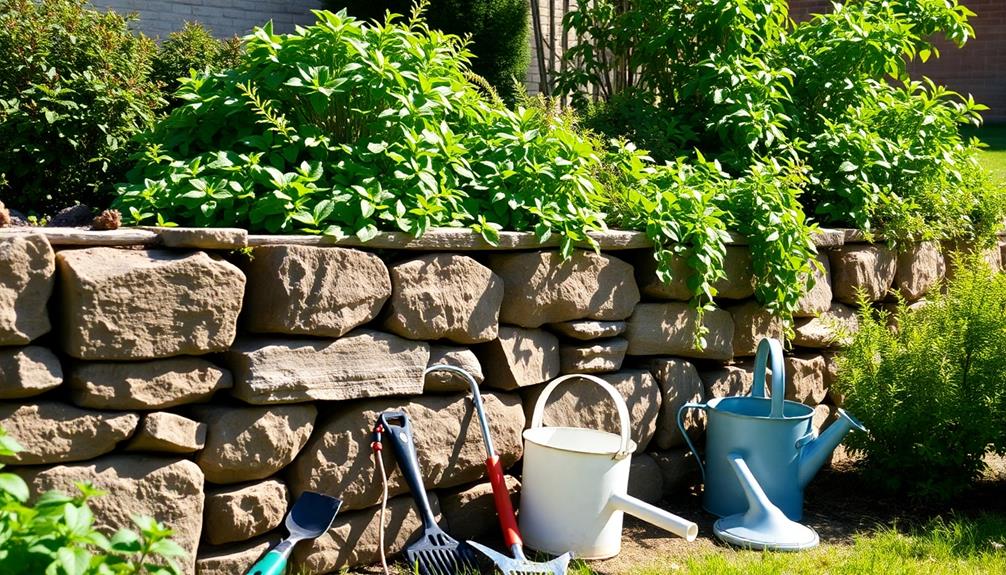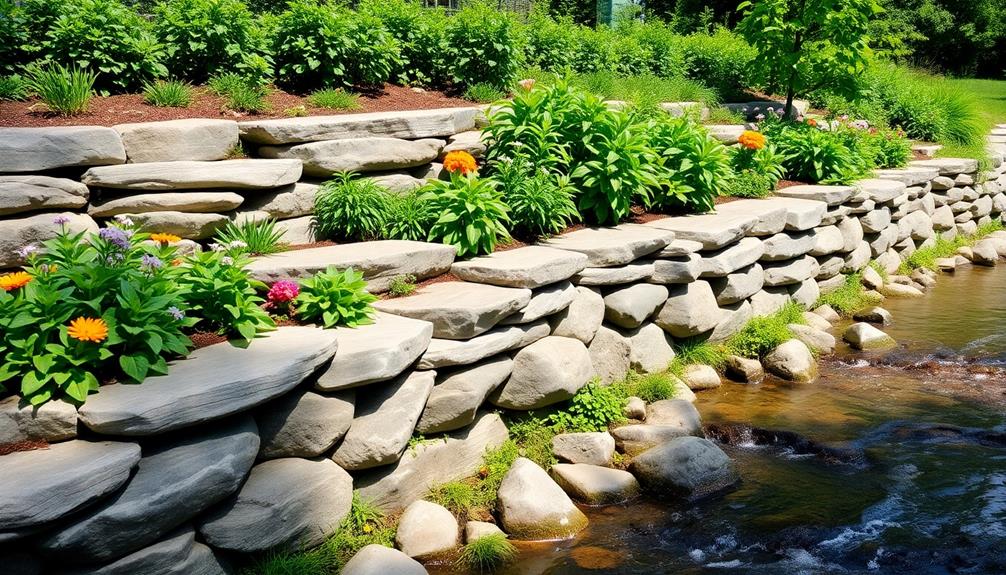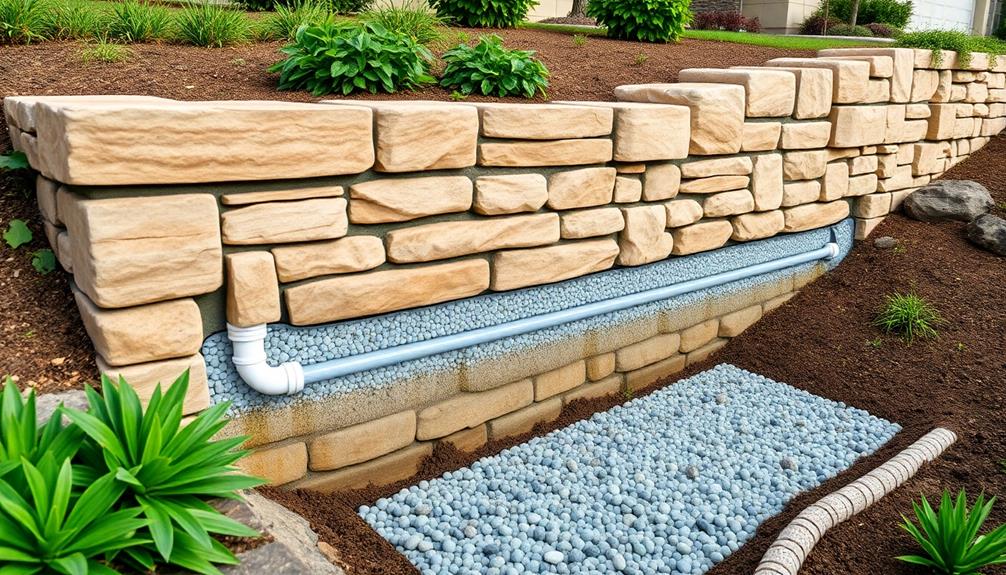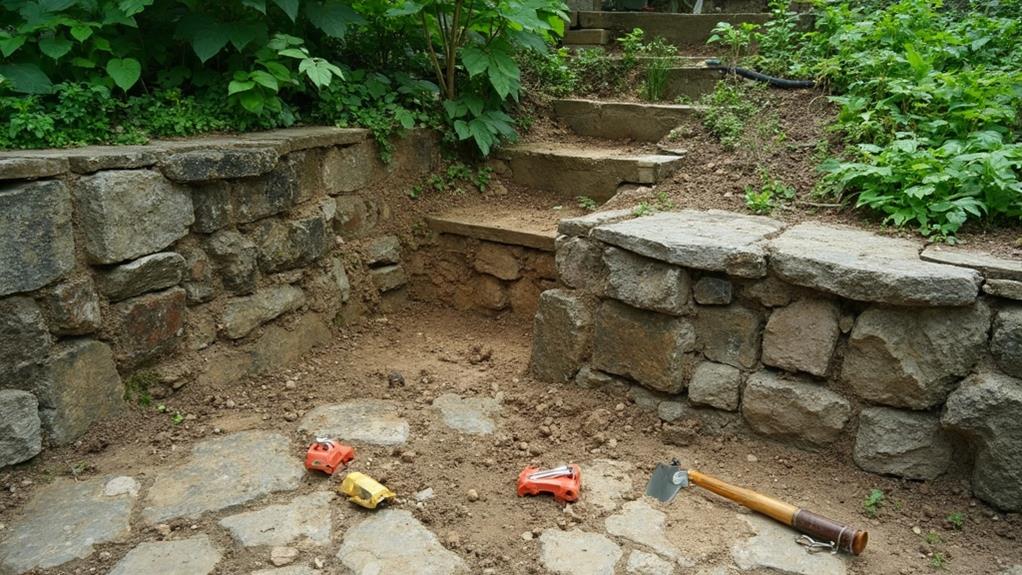Regular maintenance of retaining walls is essential to preserving their structural integrity and ensuring long-term functionality. This includes diligent inspections to identify cracks, bulges, or leaning that might compromise stability. Regular cleaning of drainage systems is vital to prevent clogging and hydrostatic pressure, which can lead to costly repairs and potential failures. Monitoring soil conditions assists in addressing concerns such as erosion and subsidence, maintaining stability and aesthetics. Additionally, well-kept walls contribute to increased property value and reduced safety hazards. Preventative measures are key to avoiding expensive restorations and ensuring lasting performance, inviting you to understand the intricate relationship between maintenance and durability.
Table of Contents
ToggleWalls Contractor Highlights
- Regular maintenance identifies structural issues early, preventing costly repairs and ensuring wall safety.
- Proper drainage maintenance prevents water buildup and hydrostatic pressure, preserving wall stability.
- Routine inspections uphold soil stability and prevent erosion, protecting wall integrity.
- Regular upkeep enhances visual appeal, curbing potential deterioration and increasing property value.
- Consistent maintenance fosters community trust by ensuring the wall's ongoing functionality and safety.
Retaining Wall Maintenance Basics

Effective maintenance of retaining walls begins with regular inspection for structural damage, ensuring early identification of issues such as cracks, shifts, or erosion that could compromise the wall's integrity.
To enhance stability, consider the appropriate retaining wall materials for your specific setting, as different materials offer varying levels of durability and aesthetic appeal. Equally important is the routine cleaning of drainage systems to prevent blockages that can lead to water accumulation and subsequent pressure on the wall.
Monitoring soil conditions, including moisture levels and any changes in soil stability, is essential to anticipate and mitigate potential problems that might affect wall stability.
Inspect for Structural Damage
Conducting regular inspections for structural damage is a critical aspect of maintaining the integrity and longevity of any retaining wall. The visible signs of wear and tear, such as cracks, bulges, or leaning sections, are indicators of underlying issues that need prompt attention.
Addressing these signs early not only preserves the wall's structural soundness but also fosters a sense of safety and reliability among stakeholders reliant on its functionality.
A thorough inspection should include evaluating the condition of both visible and hidden structural elements. This involves carefully examining mortar joints, if applicable, and analyzing the stability of adjoining soil and vegetation, which could impact the wall's performance.
The importance of these inspections lies in their ability to preempt potentially costly repairs, thereby safeguarding the investment in your retaining wall and reinforcing community trust in its continued operation.
Clean Drainage Systems Regularly
Regular cleaning of drainage systems is paramount in maintaining the functionality and durability of retaining walls. Guaranteeing that water drains away from and does not accumulate behind a retaining wall can prevent structural issues and extend the wall's lifespan. Clogged drainage systems can lead to increased hydrostatic pressure, which may cause significant damage, including wall displacement or even failure. Regular maintenance involves inspecting and cleaning drain pipes, weep holes, and gravel backfill to secure efficient water flow.
By incorporating routine checks into a maintenance schedule, property owners and managers demonstrate a proactive approach, fostering an environment of safety and reliability. Clear communication and collaboration with specialized contractors or professionals are fundamental to achieving ideal results. Employing cost-effective solutions, such as installing high-quality filters or synthetic cloth wraps over the drainage outlets, can further prevent debris build-up.
This thorough care underscores the significance of teamwork in property maintenance, offering a sense of belonging to those invested in nurturing and preserving their assets. Community members who partake in these efforts contribute to the overall stability and aesthetic appeal of shared spaces, enhancing both individual and collective satisfaction in maintaining a sound, well-cared-for infrastructure.
Monitor Soil Conditions
Monitoring soil conditions is a vital component of retaining wall maintenance, as soil stability directly impacts the integrity and longevity of the structure. With varied soil compositions and environmental dynamics playing pivotal roles, it is essential to regularly assess soil conditions surrounding your retaining wall. This helps to identify and mitigate potential issues such as erosion, subsidence, or water pooling, which could compromise the wall's functionality and aesthetic appeal. A proactive approach involving soil testing, moisture content analysis, and surface inspections guarantees that any shifts in soil consistency or composition are addressed promptly.
Ensuring cooperation among property owners, landscapers, and structural engineers fosters a communal expertise, enhancing the overall effectiveness of these inspections. Such synergy contributes to maintaining a stable, supportive environment for the wall, boosting confidence in the entire containment system. Moreover, landscaping choices such as vegetation types significantly influence soil health; thoughtful selection of ground cover can prevent erosion and manage moisture levels effectively, synergizing with engineered solutions for inclusive soil management.
Ultimately, by fostering a meticulous approach to monitoring soil conditions, stakeholders are granted peace of mind, knowing that their investment in retaining walls continues to support both property aesthetics and structural soundness over time.
Benefits

Proper maintenance of retaining walls offers numerous advantages that are pivotal for both structural integrity and economic benefits. By preventing structural failures through regular inspections and necessary repairs, these walls not only enhance their longevity and strength but also contribute considerably to improving the aesthetic appeal of a property.
Regular maintenance also secures the wall's compatibility with drainage requirements and helps prevent soil erosion. Consequently, well-maintained retaining walls can lead to an increase in property value, making them a worthwhile investment for property owners.
Prevent Structural Failures
Maintaining the integrity of retaining walls is essential to prevent structural failures and maintain safety. These structures play a critical role in supporting and fortifying landscapes, and any compromise in their stability could lead to catastrophic outcomes including soil erosion and property damage. Regular maintenance, consequently, is not simply a matter of aesthetics but a fundamental obligation to secure the well-being of both the environment and community members who rely on the safety these walls provide.
Professional inspection services meticulously assess retaining wall conditions, identifying early signs of disrepair, such as cracks, bulges, or water pooling, which could herald more serious issues. By addressing these signs promptly, maintenance services prevent small problems from escalating into significant structural challenges, thereby curtailing potential economic liabilities and safeguarding occupants against hazards.
Moreover, technicians utilize specialized techniques to maintain the wall's foundation remains robust, adapting to environmental stresses and dynamic loads over time. This proactive approach not only preserves the operational effectiveness of the retaining walls but also fosters a shared trust in the infrastructure that supports the community's landscape. It is through these diligent efforts that the integrity and resilience of retaining walls are consistently sustained.
Enhance Longevity and Strength
Enhancing the longevity and strength of retaining walls provides substantial benefits, upholding their reliability under various stressors over time. Retaining walls serve as the backbone of landscapes, holding soil in place, managing water flow, and supporting various architectural and landscaping aspirations.
Consequently, their maintenance is not merely about preservation but about fortifying the structures against premature wear and unforeseen environmental impacts. As retaining walls age, they can face challenges from natural elements such as water, temperature fluctuations, and root systems, which may cause cracks or destabilization.
Employing regular maintenance regimens empowers these structures to endure, preserving both functionality and structural integrity. This involves examining potential weak points and reinforcing them, ensuring that the wall's core remains undisturbed by external pressures.
Additionally, methods such as applying suitable sealants and employing effective drainage systems aid in protecting the materials from moisture-induced decay, which is a common catalyst for structural compromise. Periodically realigning displaced components ensures that the forces distributed across the wall are evenly managed.
Ultimately, meticulous attention to the wall's condition fosters a legacy of endurance and fortifies its role as a steadfast element within your landscape, underpinning the shared security and aesthetic value of the community.
Improve Aesthetic Appeal
With an eye toward improving aesthetic appeal, retaining walls can transform outdoor spaces into visually striking landscapes. Regular maintenance is essential in guaranteeing that retaining walls not only fulfill their functional role but also enhance the visual dynamics of a property, creating a sense of cohesion and beauty within the environment.
Thoughtfully tended retaining walls, free from cracks and weather-induced discolorations, project an image of care and sophistication, seamlessly blending with surrounding natural elements and architectural features.
The maintenance of retaining walls involves various processes aimed at preserving and enhancing their appearance. Cleaning the surface of walls removes dirt and organic build-up that may obscure the stonework or masonry details. This not only prevents potential damage but also revives the wall's original colors and textures.
Additionally, inspecting for and repairing minor cracks or chips helps maintain the wall's integrity and guarantees a polished look.
Incorporating elements like lighting, plants, or ornamental designs during maintenance can further elevate the aesthetic charm of retaining walls. Emphasizing such enhancements fortifies the wall's role as both a structural necessity and a decorative attribute, fostering a welcoming atmosphere that invites community and connection within outdoor spaces.
Increase Property Value
A well-maintained retaining wall frequently contributes to increasing property value, offering both immediate and long-term financial benefits. For homeowners aspiring to create a welcoming and secure living environment, the attention to such structural features becomes indispensable.
A diligently cared-for retaining wall not only enhances the surrounding landscape but also assures prospective buyers of the property's robustness and sustainability, thereby potentially elevating its market desirability.
Regular maintenance guarantees:
- Structural Integrity: By preventing erosion and water damage, a stable wall assures buyers of less future maintenance costs.
- Aesthetic Appeal: A clean, well-kept wall enhances curb appeal, presenting a polished image that attracts interest.
- Safety Assurance: A solid retaining wall diminishes safety hazards, safeguarding both the home and its inhabitants.
- Cost Efficiency: Preventative care mitigates the need for expensive repairs or replacements, proving financially prudent.
The existence and upkeep of such retaining structures can consequently influence appraisals and negotiations, positioning properties favorably within the real estate market. By prioritizing maintenance, homeowners foster a sense of belonging through creating a valued, safe, and visually appealing environment that stands the test of time, benefitting both themselves and the community at large.
Drainage System Crucial Detail

An effective drainage system is a pivotal feature within retaining wall installations, as it serves a fundamental role in guarding against water accumulation, thereby mitigating potential damage to the wall's structural integrity. Properly engineered drainage channels allow for efficient water egress, sustaining the wall's stability while concurrently minimizing the risk of soil erosion that can undermine its foundation. Below is a table summarizing the key benefits of an efficient drainage system:
| Benefit | Description | Outcome |
|---|---|---|
| Prevents Water Accumulation | Channels water away from the wall, avoiding pressure build-up | Extended lifespan of the wall |
| Secures Structural Stability | Maintains the physical integrity of the wall by regulating moisture levels | Safe and durable construction |
| Reduces Soil Erosion | Minimizes soil displacement by controlling water flow and distribution | Maintained landscaping appeal |
Prevents Water Accumulation
Proper drainage systems are a cornerstone of effective retaining wall maintenance, essential for preventing water accumulation behind the wall. When water gathers due to inadequate drainage, it greatly elevates pressure on the retaining structure, often leading to erosion or even structural failure. This critical maintenance aspect guarantees the wall's longevity by allowing controlled water passage and preventing undue stress. Understanding the importance of these systems fosters a sense of community pride in well-maintained landscapes and shared values.
To protect investments in retaining walls and contribute to a durable and aesthetically pleasing environment, consider the following benefits of an efficient drainage system:
- Prevents Erosion: Excess water can erode the soil, compromising the wall's foundational integrity.
- Reduces Hydrostatic Pressure: Proper drainage helps alleviate the pressure exerted by standing water, reducing strain on the wall.
- Prolongs Material Lifespan: By keeping the materials dry, a drainage system extends the life of the wall components.
- Minimizes Freeze-Thaw Damage: Effective drainage mitigates the effects of freezing and thawing cycles, which can crack and weaken the wall over time.
Properly maintained drainage systems not only uphold the physical integrity of a retaining wall but also reflect a collective commitment to efficient property management and community aesthetics.
Ensures Structural Stability
In the domain of retaining wall maintenance, efficiently controlled drainage directly impacts structural stability. A robust drainage system prevents water accumulation behind the wall, which can drastically increase hydrostatic pressure, posing serious challenges to the structure's integrity. Regular inspection and maintenance of drainage components such as weep holes, perforated pipes, and gravel backfill layers are indispensable. These elements collectively guarantee that water is directed away from the wall swiftly, mitigating the risk of additional pressure that could lead to wall failure.
Moreover, drainage systems must be tailored to suit the specific environmental conditions surrounding the retaining wall. Factors such as soil type, rainfall intensity, and slope gradient influence the design and regular upkeep strategy. Engaging with a knowledgeable maintenance service that understands these complexities fosters a sense of confidence and belonging, knowing that one's retaining wall is in expert hands.
The integration of advanced materials and techniques in contemporary drainage solutions—like geotextiles and prefabricated drainage composites—further assures structural resilience. Embracing these innovations through diligent maintenance exemplifies the commitment to longevity and stability, safeguarding not only property but also enhancing communal aesthetics and safety. Such dedication ensures your retaining wall remains a steadfast fixture in the landscape.
Reduces Soil Erosion
Effective drainage systems play a pivotal role in reducing soil erosion around retaining walls. As these structures withstand the relentless force of gravity and the dynamic energy from water flow, they require efficient drainage to siphon water away efficiently, preventing undue stress on the wall and surrounding soil. When managed properly, these systems not only preserve the structural integrity of the retaining wall but also contribute to a stable and harmonious environment for its users.
A well-engineered drainage system provides several benefits:
- Water Diversion: This process effectively directs water away from the wall, preventing pooling and potential erosion at its base.
- Reduced Hydrostatic Pressure: By decreasing pressure build-up behind the wall, drainage mitigates the risk of wall failure.
- Enhanced Longevity: Proper water management reduces wear and tear, extending the wall's lifespan and reducing maintenance costs.
- Groundwater Management: Limits groundwater saturation in the soil, diminishing the likelihood of landslides or soil displacement.
Each of these elements underscores the importance of regular maintenance for drainage systems, ensuring that they function suitably. For communities relying on retaining walls, integrating a thorough, regularly maintained drainage strategy fosters a sense of security and cohesion, emphasizing the core value of collective safety and well-being.
Walls Contractor FAQ
What Materials Are Best for Constructing Long-Lasting Retaining Walls?
For constructing durable retaining walls, materials such as poured concrete, natural stone, and reinforced concrete blocks are recommended. These materials provide longevity, structural integrity, and enhance the aesthetic appeal, fostering a sense of community pride in shared spaces.
How Often Should a Professional Inspect My Retaining Wall?
It is recommended that retaining walls are professionally inspected annually to verify structural integrity and functionality. Such regular assessments foster a sense of security and community trust, reinforcing the collective commitment to safety and longevity of shared spaces.
Are There Signs That Indicate a Retaining Wall Is Failing?
Identifying warning signs of retaining wall failure, such as cracking, bulging, or water seepage, is essential. Being vigilant fosters community safety and preservation. Trust in skilled professionals to guarantee structural integrity and prevent potential hazards.
Can Landscaping Around a Retaining Wall Affect Its Durability?
Landscaping near retaining walls can markedly impact their durability. Incorporating improper drainage, using plants with aggressive root systems, or adding excessive weight can compromise structural integrity, emphasizing the need for thoughtful planning and collaboration with skilled professionals.
How Can I Prevent Pests From Damaging My Retaining Wall?
To prevent pests from damaging your retaining wall, utilize barriers, regular inspections, and natural repellents. Consider professional pest control services for an all-encompassing solution, ensuring the structure's longevity and your membership in a community of responsible property owners.







